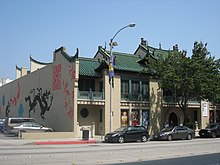Grace Nicholson

Grace Nicholson (December 31, 1877 – August 31, 1948) was an American art collector and art dealer, specializing in
Early life and education
Grace Nicholson was born in
Nicholson attended Philadelphia High School for Girls, graduating in the class of 1896. She briefly worked as a stenographer after high school.[2]
Career

In 1901, using her inheritance, Nicholson moved to California, and soon opened a small shop in Pasadena, selling Native American handicrafts such as baskets and weaving.[3] She hired crafters to teach traditional beadwork and other skills; she rented space to local artists. She traveled extensively in the rural western and Southwestern United States, worked with local dealers to build her collection, and corresponded with East Coast collectors to sell the objects.[4] She personally photographed and catalogued her holdings; she also built an extensive photographic record beyond the objects, especially of the Klamath River people, with whom she had frequent dealings.[5][6] She developed longterm relationships with some favorite crafters, well beyond ordinary business dealings: she paid for eye surgery for one ailing basketmaker,[7] and paid college tuition for another young woman.[8]
Nicholson acquired artifacts for sale, but also for major museums such as the

In 1924, she designed a new building for her collections, which (reflective of changing fashions) had begun to focus on Asian art.[12][13] The architectural firm of Marston, Van Pelt & Maybury worked with Nicholson to realize her vision. Her design, nicknamed the "Treasure House," borrowed elements from buildings she had seen in China.[14] The building was opened as an art gallery and shop in 1925, although the interior garden courtyard was not completed until 1929.
The
Her building was deeded to the City of Pasadena in 1943, but she continued to live in her private apartment on the second floor until her death from cancer in 1948.[12][26]
Personal life
Nicholson was an active charter member of the Zonta Club of Pasadena, and hosted meetings at her home, including a 1929 Christmas party attended by Amelia Earhart.[27]
Legacy
Nicholson's papers and photographs were donated to the Huntington Library in 1968.[28][29] Nicholson's 1925 building is now home to the USC Pacific Asia Museum.[12] Much of her private collection of artifacts was incorporated into the holdings of the Smithsonian's National Museum of the American Indian.[7] Another large collection of items purchased from Nicholson was bequeathed to the Montclair Art Museum in New Jersey, by Florence Rand Osgood Lang.[30]
A Grace Nicholson scholarship for women students who demonstrate artistic talent was established at Scripps College in 1951.[31]
In 2010, over two hundred sacred and ceremonial items collected by Nicholson and purchased from her by George Gustav Heye were repatriated to the Yurok people, one of the largest repatriations in the history of the National Museum of the American Indian.[32][33]
References
- ^ Finding Aid, Grace Nicholson Papers, Huntington Library.
- ^ Rhonda Packer (1994). "Grace Nicholson: An Entrepreneur of Culture," Southern California Quarterly 76(3): 309–310. DOI: 10.2307/41171730
- ISBN 0826329284.
- ^ Daniel Usner (2012). "ASE Address 2011: An Ethnohistory of Things: Or, How to Treat California's Canastromania," Ethnohistory 56(3)(Summer): 441v463.
- ISBN 0813531705
- ISBN 0520207971; Cohodas notes, "Nicholson's records provide almost inparalleled documentation of a single weaver." (143).
- ^ a b Ed Liebowitz, "Token of Appreciation: A Grateful Pomo Indian's Gift to a Friend Exemplifies the Brightest Form of Native American Artistry," Smithsonian Magazine(August 2004).
- ^ Hover Photograph Collection-Finding Aid, Humboldt State University Library Special Collections.
- ^ Rhonda Packer and Tamar Frankiel (1995). "Natural Sympathies: Anglo Women and Indians in the West, 1895–1920," International Social Science Review 70(3&4): 69.
- ^ "Scientists See Burbank's Work: Members of Anthropological Society Visit Horticulturist at his Santa Rosa Home," San Francisco Chronicle (September 2, 1905): 3.
- ^ Report, California Alaska-Yukon Pacific Exposition Commission (1910).
- ^ a b c ""The Grace Nicholson Building," USC Pacific Asia Museum website". Archived from the original on 2014-05-28. Retrieved 2014-06-21.
- ISBN 0393320065.
- ^ "She Adds Another 'Treasure' to Store: Pasadena Art Dealer Favors Chandler Car," Los Angeles Times (August 16, 1925): H15.
- ^ "Display of Hawaiian Paintings Announced," Los Angeles Times (February 25, 1928): A5.
- ^ Antony Anderson, "Of Art and Artists: The Wanderer; The Week in the Local Galleries," Los Angeles Times (15 March 1925): 26.
- ^ Antony Anderson, "Of Art and Artists: The Pier," Los Angeles Times(March 22, 1925): 34.
- ^ Antony Anderson, "Three Exhibits at Grace Nicholson's," Los Angeles Times (March 14, 1926): C19.
- ^ Arthur Millier, "Art and Artists: Of Interest to Artists," Los Angeles Times (October 9, 1927): 30.
- ^ "Art Exhibitions in the Southland," Los Angeles Times (December 11, 1927): C32.
- ^ "Art and Artists: Current Art Exhibitions," Los Angeles Times (December 2, 1928): C25.
- ^ "Current Art Exhibitions," Los Angeles Times (April 7, 1929): C16.
- ^ "Age and Youth From East to West," Los Angeles Times (May 19, 1929): 18.
- ^ Antony Anderson, "Of Art and Artists," Los Angeles Times (January 3, 1926): C26.
- ^ "Art and Artists: Great Exhibit in Pasadena; a Group of Old Tapestries/ Rare Coptic, Persian, and Chinese Ceramics; the Jaehne Collection of Japanese Crafts," Los Angeles Times (March 18, 1928): C16.
- ^ "Miss Grace Nicholson," The New York Times (September 2, 1948): 23.
- ^ Zonta Club of Pasadena: History (website) Archived 2014-03-26 at the Wayback Machine.
- ^ Suzanne Oatey, "A Life of Adventure," Verso (April 18, 2014).
- ^ Marvin Cohodas (1997). Basket Weavers for the California Curio Trade: Elizabeth and Louise Hickox (University of Arizona Press): 176.
- ISBN 0826329284
- ^ "Scripps College Office of Financial Aid: Scholarships (website)". Archived from the original on 2014-06-21. Retrieved 2014-06-21.
- ^ John Driscoll, "Back Home Where They Belong: Yurok Tribe Celebrates Return of Dance Regalia from Museum," Times-Standard (August 14, 2010).
- ^ Peter Fimrite, "Yurok Indians Exult at Return of Sacred Cache," San Francisco Chronicle (August 13, 2010).
